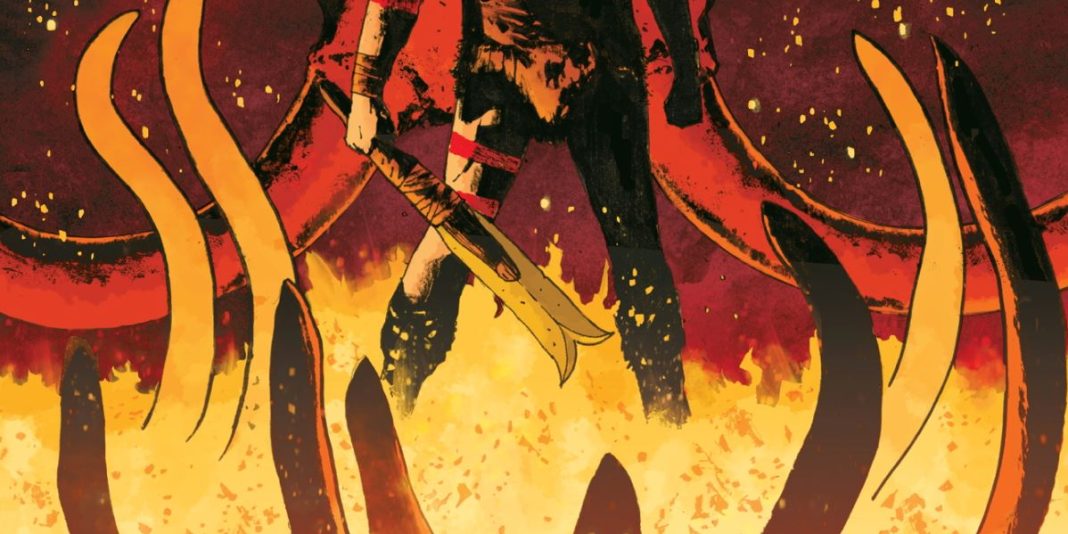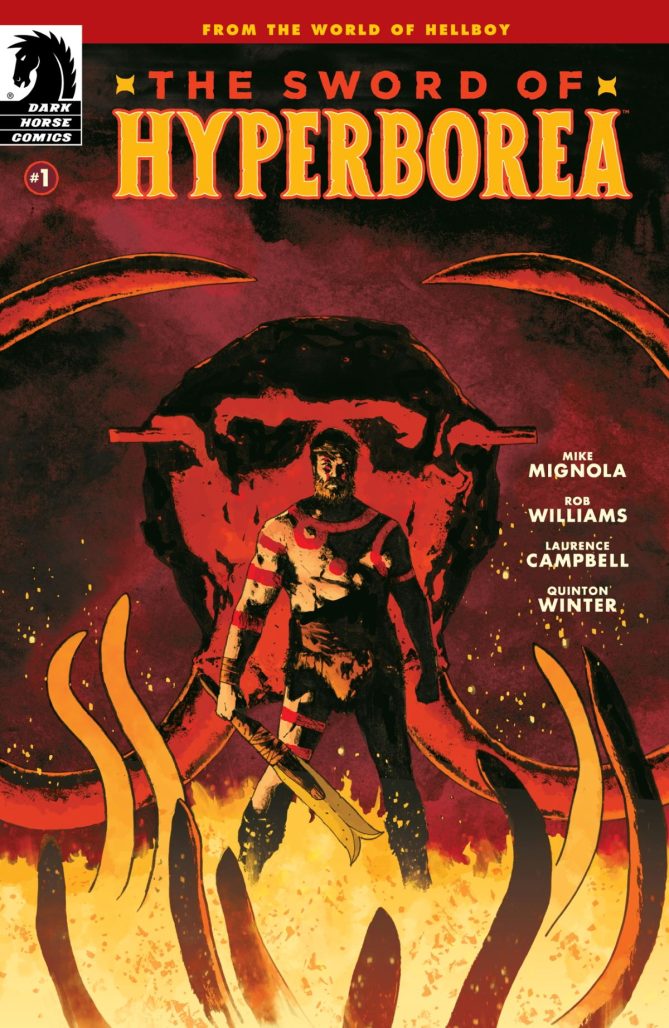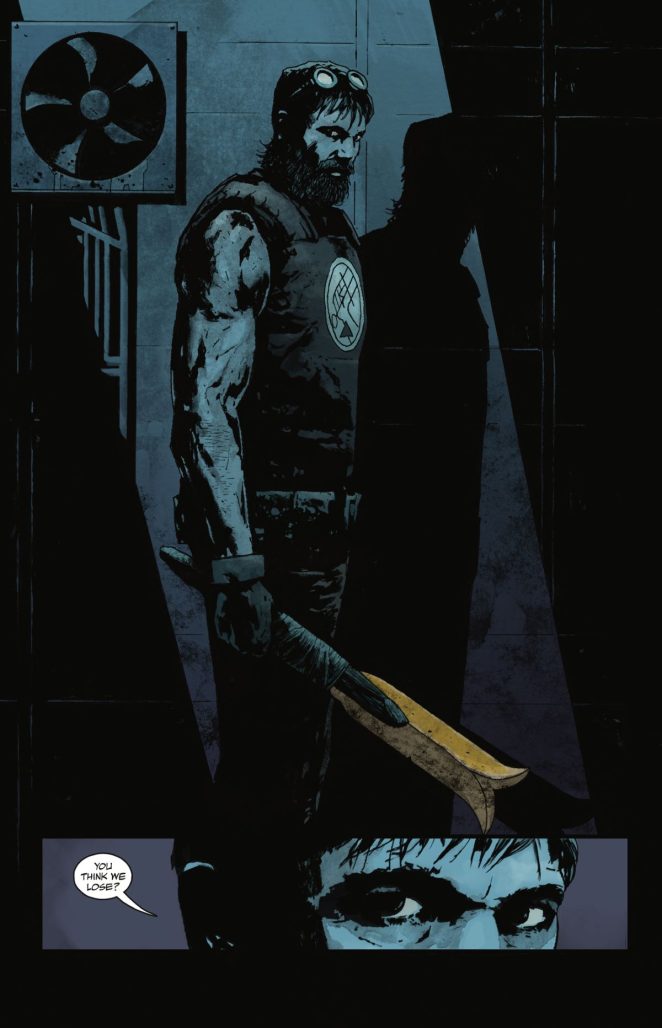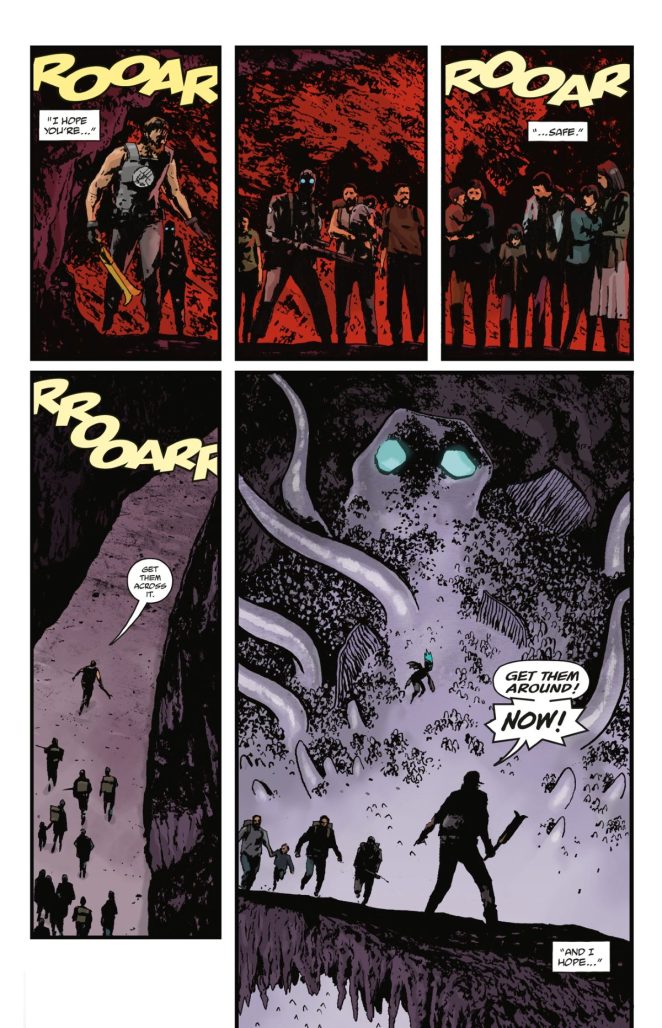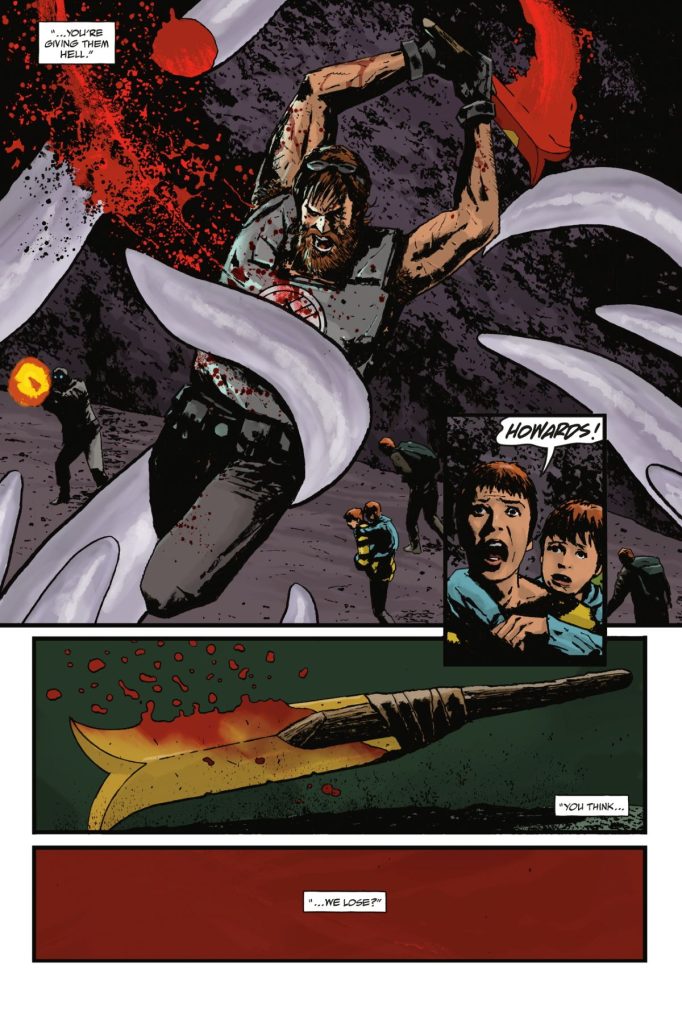The Sword of Hyperborea marks the latest team up between writer Rob Williams and artist Laurence Campbell. It also marks Williams’ entry into the ever-broadening mythos of Mike Mignola‘s Hellboy and the B.P.R.D.
The Hyperborean blade has shown up periodically in the Mignolaverse. Sir Edward Grey possessed it in the late 19th century (in the 2009 miniseries Witchfinder: In the Service of Angels) and that same blade made it to the present day with Gall Dennar/Agent Howards in the pages of 2013’s B.P.R.D. Hell on Earth: The Abyss of Time. The Sword of Hyperborea series promises to show glimpses of where it has been – starting with the end: with Agent Howards and his connection to the ancient warrior Gall Dennar.
Stately Beat Manor sent local clock-fixer Dean Simons to conduct an email interview with Rob Williams about this time-spanning new series, the reveals of the first issue, and what is to come.
Dean Simons: Hi Rob, I believe this is your debut to the world of Hellboy and the B.P.R.D. How did you get involved in this project? What drew you to taking it on?
Rob Williams: Laurence Campbell, our amazing artist on The Sword of Hyperborea, had been working on B.P.R.D. stories with Mike Mignola and the team for the last five years or so, off and on. Laurence had been talking to them about a story regarding Gall Dennar, our barbarian lead in issue #1, and he asked me if I’d be interested in writing the series. Laurence and I had just done a creator-owned book together (Old Haunts for AWA) and I’d previously talked to Katii O’Brien, the Hellboy editor, about my maybe doing some B.P.R.D. stories. So it all came together. As for what attracted me? It’s always great working with Laurence, who’s a real master of mood on the page, and I’d been a fan of the Hellboy and B.P.R.D. stories for years.
Simons: What was it like working with Mike Mignola on the story and script? How much plotting and planning was there? How does it compare to your other work, where you are sole writer/plotter?
Williams: Well, it goes without saying that this world is Mike’s and he knows the ins and outs of it, so all roads go through him. Mike had a plot in mind for Gall Dennar’s journey in issue #1, and we sort of used that as our spine and built out from there. Then we had a couple of Zoom calls with him to talk about the sword––our ‘Excalibur’ magic weapon––its history, where it came from, where it ends up, and in whose possession. Laurence was involved in the plotting of the series throughout, too. It was all very collegiate. And then issues #2–#4 were really me and Laurence left to chart our own path with input from Mike. We’re sort of dancing between Mike’s existing plot points and creating new strands along the way.
Simons: Can you tell us more about working with artist Laurence Campbell? How collaborative was the process between the three of you?
Williams: Well, I’ve worked with Laurence a number of times over the years, most recently on Old Haunts. But we’ve done work for Marvel and 2000AD. We’re friends and talk a lot, and have many of the same touchstones. I find he knows what I’m asking for in a script. But with The Sword of Hyperborea, Laurence had put together a bunch of visual moodboard stuff for issue #1 before I ever came onboard. It was his idea to do a story where we move through history and meet the different sword-bearers. This wasn’t the usual ‘I write script, you draw script’ dynamic. We approached it the same way we would have our own creator-owned project, really.
Simons: The first issue appears to be the continuation of Gall Dennar/Agent Howards story following the events of the main B.P.R.D. series, which concluded the world literally ending in 2019’s The Devil You Know. Was this an idea you pitched?
Williams: No, that was Mike’s plot. <Spoilers. But if you’ve read B.P.R.D.:The Devil You Know then you know that the monsters win and the earth burns.> Mike had Gall Dennar waking up thousands of years in the past on a funeral pyre with the knowledge of what happens way in the future. That humanity loses. That all his battles are for nought. Thematically, what interested me from that point was the question of what you do when you know it’s already over––which is a little meta, I guess, considering that we’ve seen how Hellboy’s journey ends. Can you find something worthwhile and worth fighting for after that? For Gall Dennar it’s an epic quest across his landscape to try and find the mythic warriors of old, who put power into the sword. If he can find them, and their power, maybe he can change the future?
Simons: Can you give our readers an idea of the themes (loss, hopelessness) explored in the story and why you guys took it in that direction? I must admit it was unexpected and quite interesting.
Williams: I guess, in one way, Gall Dennar’s journey is no different from any of ours––albeit in a barbarian landscape with way more saber-toothed tigers and the odd pterodactyl. Without bumming readers out, we all know where our life’s journey goes. “I cannot live in a world without hope,” Gall says. So we invent quests for ourselves while we’re here, to give ourselves purpose, and along the way we find good, and we experience love, and we find moments worth living for.
Simons: The dialogue is relatively sparse in this book compared to your other work, seemingly in keeping with that of many prior Mignolaverse titles. Is there a tacit rule or did you feel that so much is already (admittedly brilliant handled) by Campbell? Did you find yourself removing elements from your script?
Williams: I’m old and battered enough to know, I think, that this is first and foremost a visual medium. And if you’ve got a bloody good artist, then part of the writer’s job is to write the scene and get out of their way. We wanted The Sword of Hyperborea #1 to be Terrence Malick-like widescreen visuals. A journey through an impossible land. Mood. Pacing. I think knowing this was a Mignolaverse book probably influenced my scripting approach, too. Mike does silent panels and sparse dialogue better than anyone. So, try to fit in. That said, the characters and the worlds you’ll see in issues #2–#4 are quite different in approach.
Simons: You have a career of simultaneously playing in many sandboxes – from various superhero (and villain) properties at Marvel/DC to Dredd, Roy of the Rovers, and Strontium Dog over at Rebellion. How do you keep from feeling constrained by what has come before while finding room to tell a story you wish to tell? How do you keep from being frazzled by so many spinning commercial plates?
Williams: Oh, well it’s a case of not doing them all at the same time, certainly. Ideally you need to set aside headspace for one story at a time. I’ve been in positions in the past where you’re working on a number of books/worlds in the same day, and that’s really not good. As for not being constrained by what’s come before and finding room to tell a story you want to tell, you’re always a little intimidated with what’s gone before, especially when it’s playing in worlds created by people like Mike on Hellboy and John Wagner and company on Judge Dredd. But something usually sparks an idea, and then it’s often the theme. You want to say something about your life in the story, somewhere. Even if you don’t intend that going in, something about you will pop in there.
Simons: Can you tease where this series is going? Is this a self-contained series or is there the chance it could be one of many minis involving the sword?
Williams: Issues #2–#4 are really three origin stories for brand-new characters, all sword-bearers. One is a German noblewoman spy during World War I, one is an egocentric deep-sea diver at the start of World War II, and the other is a bluesman in Chicago, who is haunted by an invisible spirit who whispers secrets and instructions to him. These three could easily have more stories of their own to tell. We’re pretty excited by them, and have been talking about doing more with them. We’ll see.
Simons: What other characters in the Mignolaverse would you like to play with (aside from Big Red, himself)?
Williams: Ah, the fanboy in me would love to do a classic B.P.R.D. story, with Johann and Kate and company. The thing is, there’s already a lot of stone-cold classic B.P.R.D. stories featuring Johann and Kate and company, so maybe people should go back and read them, and we’ll try creating new stories with some new characters. That said, I’d not say no.
Sword of Hyperborea #2 drops February 16. #1 can be chased up over at your fave purveyer and procurer of the panelled page or via the Dark Horse website.


